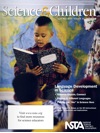Language development in science
By Mary Bigelow
Posted on 2014-04-09
 For many students, science itself is a new language, with specialized vocabulary and an emphasis on observations and evidence, rather than feelings or opinions. Even the graphics in books and websites go beyond being decorative to include the language of tables, diagrams, graphs, captions, sidebars, and footnotes. The featured articles in this issue demonstrate classroom- and teacher-tested strategies for developing language skills in the school classroom.
For many students, science itself is a new language, with specialized vocabulary and an emphasis on observations and evidence, rather than feelings or opinions. Even the graphics in books and websites go beyond being decorative to include the language of tables, diagrams, graphs, captions, sidebars, and footnotes. The featured articles in this issue demonstrate classroom- and teacher-tested strategies for developing language skills in the school classroom.
“Poets and scientists both seek to observe, explain, and understand the world around them. Poetry’s brevity, conceptual focus, and rich vocabulary make it a natural teaching tool for connecting with science” is the big idea of Observe, Explain, Connect* The article describes how teachers can “take 5” to introduce and share poems. The authors also include a sample lesson plan in which poetry is used to jump-start a science lesson (I wonder if this would be the “Engage” part of a 5E lesson?) [SciLinks: Reading and Writing in Science, Recycling]
Friction in Different Languages* describes a “sheltered instruction” approach to working with English Language Learners in a science lesson. Using a 5E format, the instructors designed a lesson in which students investigated friction. The lesson incorporated video, hands-on exploration, and experimenting with different surfaces—a good lesson that could be adapted for all students. See What Causes Friction (Science 101) if you need a refresher on the concept. [SciLinks: Friction, Force and Friction]
Putting the “Her” in Science Hero* describes an interdisciplinary unit in which students are exposed to the work of female scientists. You might ask whether in 2014 this would be necessary? Try the activity suggested in the first paragraph: Ask students to name three scientists in one minute. As the author notes, many will say Einstein and struggle for the other two. The article describes a class activity in which students learn more about female scientists and create presentations on their work.
Assessments in the Arguments* describes how “round robin” journaling can be used to assess student knowledge before, during, and after instruction, followed by round robin white boarding. In both of these strategies, students examine each other’s work and evaluate their arguments.The author describes the logistics of what this would look like in a classroom, using light as the topic to be investigated. All of the language processes (reading, writing, speaking, listening) are represented in this lesson. [SciLinks: Light]
As the authors of The Poetry of Plants* (Teaching Through Trade Books) note, April is National Poetry month—a perfect time to integrate poetry and science. In addition to two featured books, the article has two 5E lessons: Is a Seed a Living Thing (K-2) and Food for Plants (3-5). In addition to the science concepts, students use and write poetry as a way to learn and communicate. (I once observed a lesson in which high school students created haikus based on their investigation of cells—very creative and engaging!) [SciLinks: What Are Living and Nonliving Things? Photosynthesis]
A lot of time is spent on reading and writing in the classroom, but sometimes speaking and listening—the other components of language—are overlooked. In Creating Effective Classroom Interactions* (The Early Years) the author describes her reflections as she examined a video of a lesson in her classroom in which young students were asked to share their experiences. She shares the lesson, along with suggestions on how to create and learn from your own class videos. [SciLinks: Ice]
Students are never too young or too old to hear a good book, article, or story read to them. Gather ‘Round* (Methods and Strategies) has suggestions that teachers of any grade level can use for doing read-alouds and includes activities for before and after the reading. (I liked the Science A-Z chart for identifying vocabulary.)
Discussing nutrition and food choices is the theme of A Healthful Balance* with an emphasis on portion size and caloric balance. [SciLinks: Nutrition]
*And check out more Connections for this issue (April/May 2014). Even if the article does not quite fit with your lesson agenda, there are ideas and links for lesson plans, handouts, background information pages, data sheets, rubrics, trade books, and other resources.
Disclaimer: The views expressed in this blog post are those of the author(s) and do not necessarily reflect the official position of the National Science Teaching Association (NSTA).


